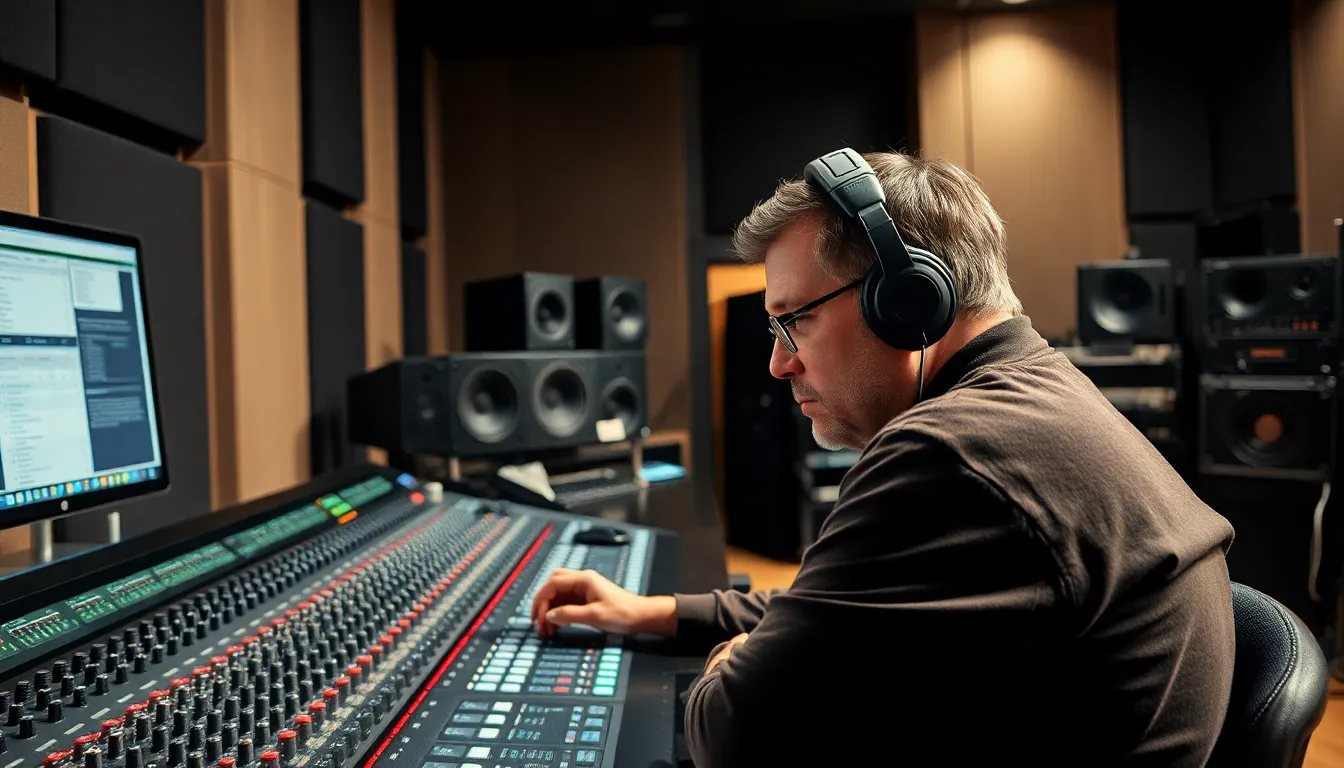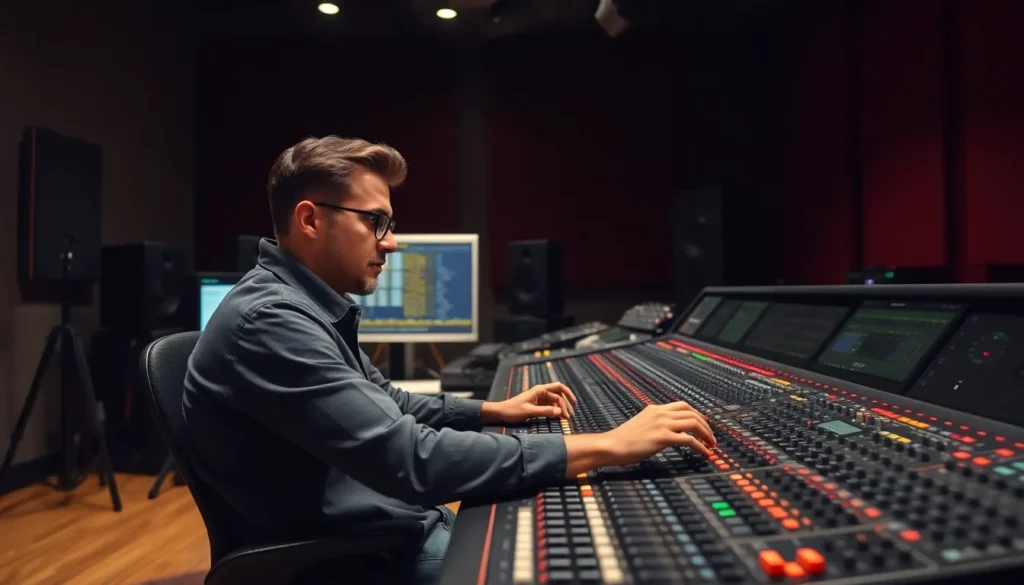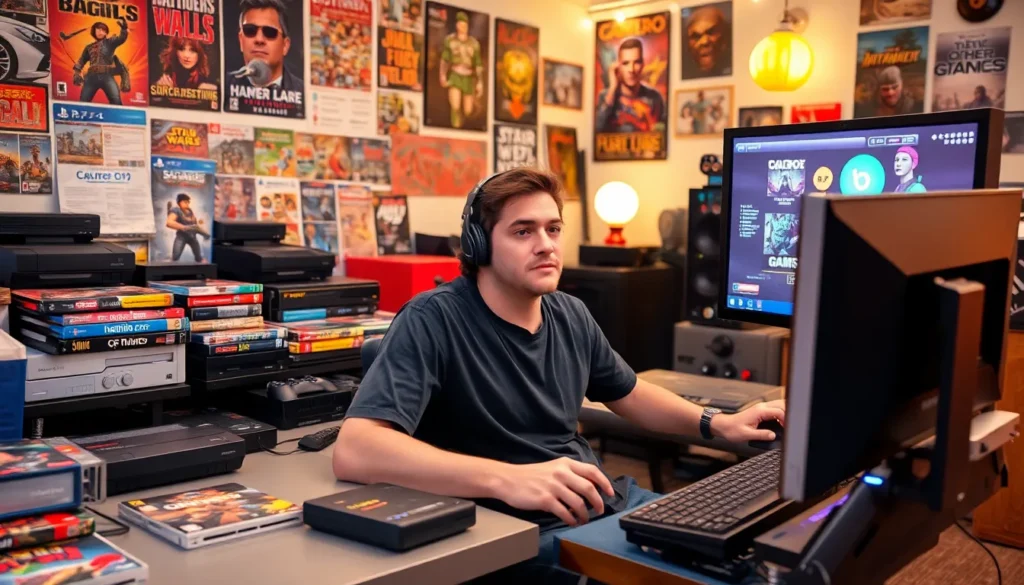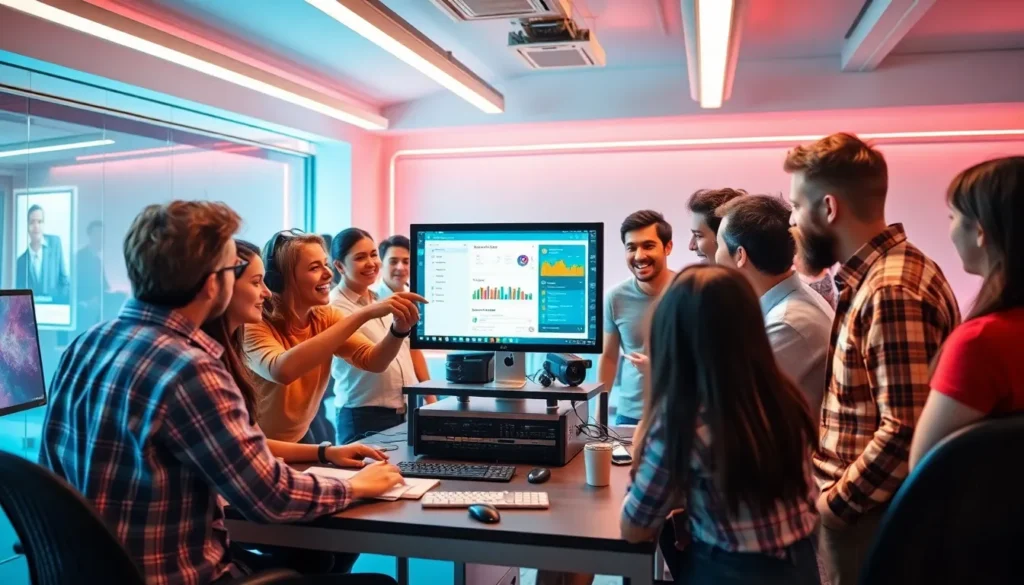Table of Contents
ToggleIn the world of movies, sound mixing is the unsung hero that often gets overshadowed by flashy visuals and gripping plots. Imagine watching an action-packed thriller where the explosions sound like a gentle pop instead of a heart-pounding blast. Not quite the adrenaline rush they intended, right? Sound mixing is the secret sauce that transforms a good film into a cinematic masterpiece, blending dialogue, music, and effects into a harmonious feast for the ears.
It’s not just about cranking up the volume or throwing in some catchy tunes. Skilled sound mixers craft an auditory experience that pulls viewers deeper into the story, making them laugh, cry, or jump out of their seats. So, next time you find yourself captivated by a film, remember that behind those captivating sounds lies a talented team working tirelessly to make sure every whisper and roar hits just right.
Overview of Sound Mixing in Movies
Sound mixing plays a vital role in filmmaking, shaping the audience’s experience beyond visuals and scripts. It elevates a film’s atmosphere, creating depth and emotion.
Importance of Sound Mixing
Sound mixing enhances storytelling by balancing dialogue, music, and sound effects. Well-executed mixing ensures clarity in conversations while supporting the story’s emotional tone. It influences audience reactions, making a tense scene more gripping or a tender moment more impactful. Skilled sound mixers adjust levels and dynamics to maintain a seamless experience, where sounds blend harmoniously. This careful orchestration invites viewers to immerse themselves deeply in the narrative, often without consciously noticing the intricacies involved.
Historical Evolution of Sound Mixing
Sound mixing has evolved significantly since the early days of cinema. Initially, films featured simple mono sound, which limited audio complexity. Innovations in technology led to the introduction of stereo and multi-channel formats in the mid-20th century, allowing for richer soundscapes. The 1977 release of “Star Wars” highlighted advanced mixing techniques, showcasing the potential of sound to enhance storytelling. Modern films utilize sophisticated digital tools that allow for intricate sound design, enhancing realism. Today’s sound mixing integrates immersive technologies like Dolby Atmos, creating a 3D auditory experience that further captivates audiences, demonstrating the ongoing evolution and importance of sound mixing in film.
Key Components of Sound Mixing

Sound mixing involves several critical components that contribute to a film’s auditory experience. Each component plays a unique role in shaping the sound landscape of a movie.
Dialogue Editing
Dialogue editing focuses on refining spoken lines within a film. This process ensures clarity and naturalness in conversations. Editors remove background noise and unwanted sounds to enhance vocal delivery. Syncing dialogue with visual cues remains a priority, aiding viewer immersion. The choice of dialogue levels greatly influences a film’s emotional tone. Precision in dialogue editing prevents distractions, maintaining audience engagement throughout.
Sound Effects
Sound effects add richness and realism to cinematic storytelling. They create auditory stimuli that enhance the action on screen. Layering different effects builds depth in scenes. From footsteps to environmental sounds, each effect has specific relevance. Creating a sound effects library with diverse choices supports filmmakers in achieving desired impacts. Consistent quality and appropriate timing of effects elevate the overall viewing experience, ensuring authenticity in the film’s world.
Music Integration
Music integration plays a pivotal role in establishing mood and emotion. Composers craft soundtracks that resonate with themes and characters. The timing of music cues enhances key moments, heightening dramatic effects. Background scores can guide audience reactions and support the narrative flow. Coordinating music with other sound elements creates a harmonious auditory environment. Mixing music with dialogue and effects requires balance, ensuring no component overpowers another while enhancing storytelling.
Techniques Used in Sound Mixing
Sound mixing employs various techniques that significantly enhance the auditory experience of films. Each technique contributes uniquely to the emotional and immersive qualities of a film’s sound design.
Stereo vs. Surround Sound
Stereo sound uses two audio channels, providing a basic spatial experience. Surround sound, however, incorporates multiple speakers around the audience, creating an enveloping sound environment. Films often utilize surround sound formats, like 5.1 or 7.1, to immerse viewers more fully in the action. Listeners perceive sounds coming from different directions, adding depth and realism. This technique allows sound designers to position effects accurately, making them more impactful.
Equalization and Compression
Equalization fine-tunes individual audio tracks, balancing frequencies to ensure clarity. Adjusting bass, mid-range, and treble frequencies enhances dialogue and music without overpowering each other. Compression controls dynamic range, softening loud sounds while boosting quieter ones. This technique ensures that the sound remains consistent across various listening environments. By applying these processes, sound mixers maintain a polished auditory landscape that supports the film’s narrative.
Audio Panning
Audio panning distributes sound across the stereo or surround field. This technique defines the placement of sound, allowing specific effects to move smoothly from one speaker to another. For instance, a car passing by can shift from left to right, heightening realism. Creatively utilizing panning enhances audience engagement by simulating a three-dimensional auditory space. This method shapes the auditory experience, ensuring that every sound element contributes to the film’s atmosphere effectively.
Challenges in Sound Mixing
Sound mixing presents unique challenges that professionals navigate to create a cohesive auditory experience in films.
Balancing Elements
Balancing dialogue, music, and sound effects proves critical in sound mixing. Dialogue needs clarity and presence without overpowering other elements. Music sets the emotional tone through its volume and timing, enhancing viewer engagement. Sound effects enrich scenes, providing realism and context while ensuring they do not distract from the dialogues or musical score. Each component must function harmoniously, creating a seamless blend that elevates storytelling.
Environmental Considerations
Environmental factors often affect sound mixing processes. Recording locations may present challenges like background noise and acoustics. These elements require meticulous attention during post-production to preserve sound quality. Mixing professionals must adapt to different playback environments, ensuring consistency across various audio systems from cinemas to home theaters. Careful consideration of these factors leads to a sound mix that retains its integrity regardless of the viewing context.
Technology Limitations
Technology limitations can hinder the sound mixing process. Equipment capabilities often dictate the complexity of sound arrangements that can be achieved. Not all projects benefit from advanced formats or high-end software; some must work with standard tools that possess restricted functionality. Limited experience or familiarity with specific technology may also affect mixing professionals’ ability to achieve desired outcomes. Overcoming these limitations often depends on creativity and resourcefulness in using available resources effectively.
Sound mixing is an essential element of filmmaking that deserves recognition. It shapes the viewer’s emotional journey and enhances the overall storytelling experience. The meticulous work of sound mixing professionals ensures that every auditory detail aligns with the film’s vision.
As technology continues to evolve the art of sound mixing, filmmakers are empowered to create richer and more immersive experiences. By appreciating the intricate balance of dialogue, music, and sound effects, audiences can gain a deeper understanding of how sound influences their connection to the narrative.
Ultimately, sound mixing not only elevates a film’s impact but also invites viewers to engage with the story on a profound level.







